Last weekend, I had a very nice chance to visit Wroclaw by car. My friend drove me and his friend Thomas from Cottbus, which took us about three hours to Wroclaw.
Lucky us with the warm sunny weather! The weather did cheer up my mood, in addition to my excitement to travel again after some time being busy and stress at some working stuff and learning German. During and right after my Master, I have had much travelling in Czech Republic, Portugal, Germany, some in France and the highlighted trip to Barcelona to reunite with my Master's colleagues; I have missed the feelings of travelling and my so-called limited photography.
We arrived at Wroclaw at about 13:00. Tina - Thomas's girlfriend was there to acquaint us with the city. We had lunch at the Grunwaldzki shopping mall - one of the biggest shopping malls here. As the result, I couldn't resist to visit some shops after the lunch with joy. Wroclaw is not only a historic city, but it also offers a wide variety of shopping convenience with modern and comfortable places, reminding me of the shopping habit that I had in Singapore.
Nevertheless, I managed to get out of the shopping mall without any "damage" in my pocket and we headed to the city's Old Market Square. Here are some pictures of Wroclaw (I noticed the similarity of the architecture here and those houses in Czech Republic, although the pitched roofs here appear steeper):
Colourful houses on the streets in the Main Market Square
The historic City Hall built in a typical 14th century brick Gothic
A number of flower shops in the Main Market Square and the street in front of the St. Elisabeth's Church:
I was curious about the two groups of statues at the crossroad Pilsusiedzka/ Swidnicka, right on the way from the main train station to the Old Town. They seem to walk down imaginary stairs on one side of the street and re-appear on the other side. Some say that it's about the transition of the German city "Breslau" to the current Polish city Wroclaw. Other opinions are that they represent the Jewish people who tried to hide underground before the WW II and come back after the WW II...
"Transition"
Wroclaw is more and more known as "The World of Dwarfs". It's interesting that the city has a number of dwarfs hidden here and there to find out... The dwarves have a long tradition here. According to the Chronicle of Wroclaw Dwarves, they have been in the city since 730 (more at www.krasnale.pl), but they gained recognition in Poland only in the 20th century, owning to Waldemar Fydrych, one of the founders of the Orange Alternative dwarf movement. The history of the Wroclaw Dwarfs is connected with the Orange Alternative movement - a name for an underground protest movement in the 1980s. Its main purpose was to offer a wider group of citizens an alternative way of opposition against the authoritarian communist regime by means of a peaceful protest that used absurd and nonsensical elements". It is said that there are over 40 dwarfs around the city.
"Sisyphuses Roll it - Roll it - Pal": Sisyphuses are two dwarfs who couldn't agree with each other. One of them pushes a stone ball and the other pushes it back.
bottom left: "Śpioch"
Sleepy is at St. Nikolas str., in the back of the historic houses "John and Margaret". There's an entrance to the Dwarf's Village. The entrance to their settlement is guarded by Sleepy. Fortunately, he isn't very vigilant. If you tiptoe to him and look through the key hole, you may see the Magic World of Dwarfs...
"Wroclovek": is the smallest of all Wroclaw lovers who knows where the heart of Wroclaw beats the strongest. He stands at Dwarf Museum in front of the Magic Twin Houses "John and Margaret". That is the Dwarf's meeting place.
I was slightly amused by a gentlement playing the dwarf-statue in front of the historic City Hall. The reason of my amusement was the thought that there are actually some "real dwarfs" here. However, with a bit of luck, I was at the right timing to "discover" the gentlement's innovative way of being shorter, which ends my (who-know) further imagination of there might still exist other sources of funny facts about the city.
"Playing the dwarf-statue"
The next day, we headed to the Wroclaw Cathedral and climbed up the narrow stone staircases to the top. The photos below are nice view over the city:
Walking around the Zentrum on a sun-shining day can be of much joy:
"The Wroclaw streets here and there in the central square and the brick interior of the St. Elisabeth's Church"
"Ostrow tumski - Bridge of lovers' locks"
" The famous Grunwaldzki Bridge"
We had a long walk finding the way to the Centennial Hall - our last target attraction of the day. As significant as it has been for a long period, Centennial Hall "is recognized as one of most remarkable pioneering architectural masterpieces of the 20th century. The daring design of municipal architect Max Berg paved the way for the bold use of reinforced concrete in the construction of large public structures. The innovative construction solutions lent the interior of the enourmous dome an extraordinary sense of lightness and harmony." This is quoted on one of the introductory posters after we passed the monument's entrance gate.
And the last pictures are devoted to those who are Fall-lovers :-). Feel the beauty of Fall in the trees, rivers and in the air of Wroclaw. I have had a very joyful time here, and perhaps we shall see each other again, Wroclaw - the City of colours and dwarfs!
Wroclaw 29 & 30.10.2010.

No comments:
Post a Comment